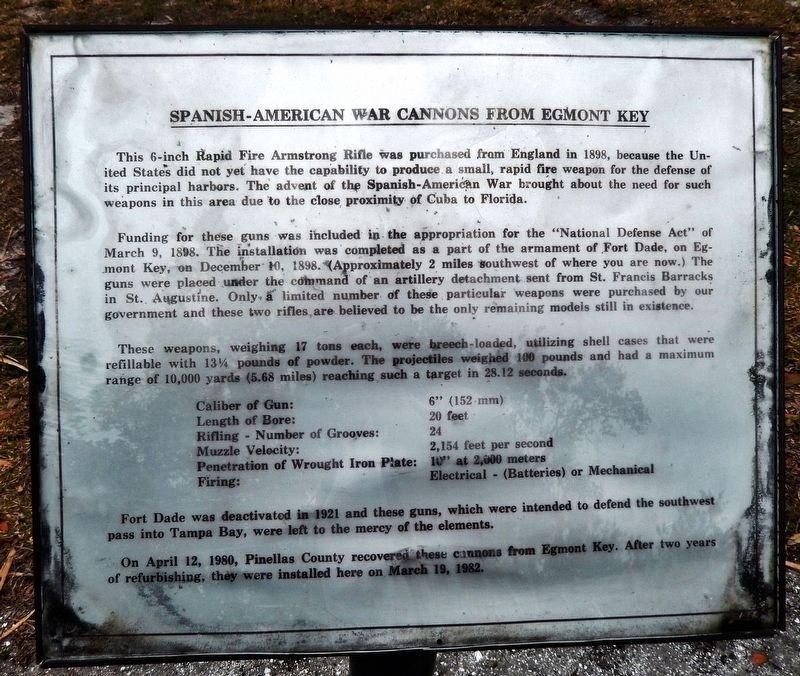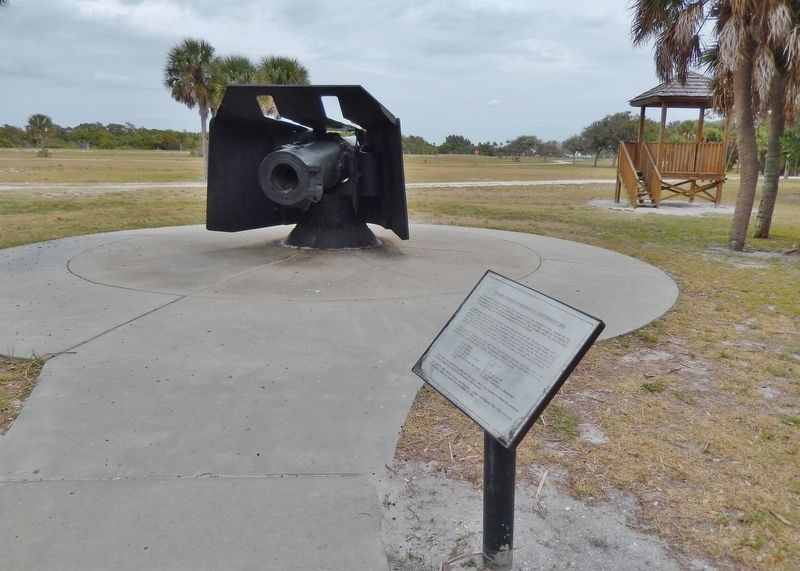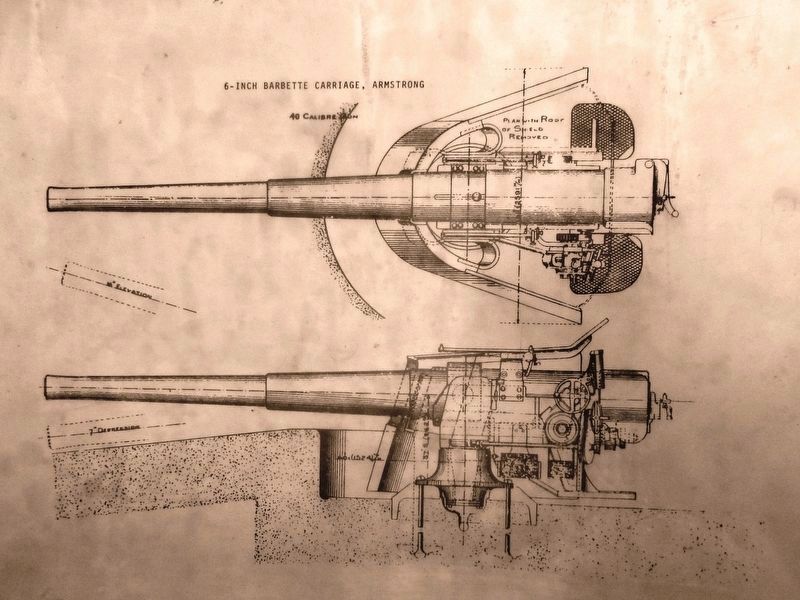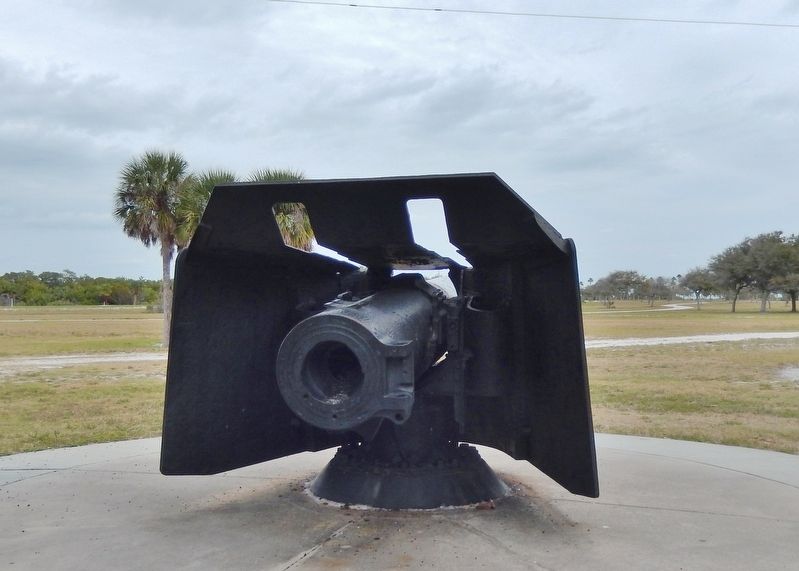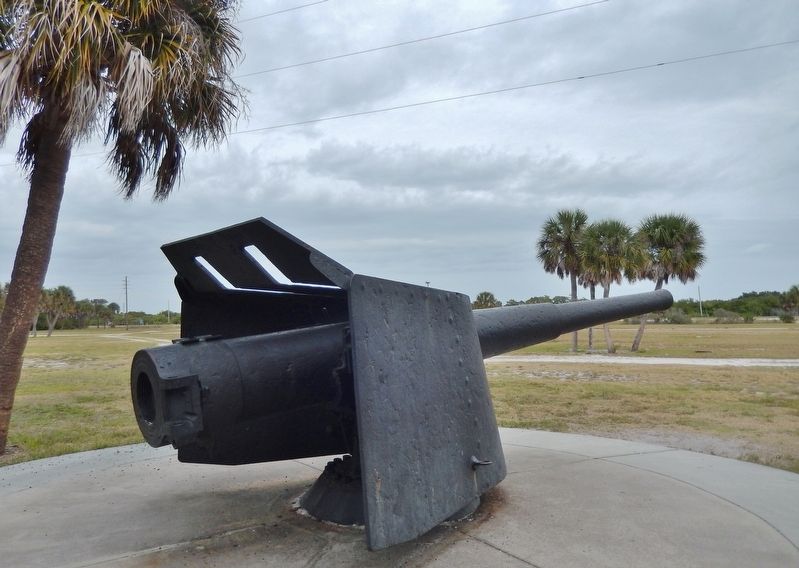Tierra Verde in Pinellas County, Florida — The American South (South Atlantic)
Spanish-American War Cannons from Egmont Key
Inscription.
This 6-inch Rapid Fire Armstrong Rifle was purchased from England in 1898, because the United States did not yet have the capability to produce a small, rapid fire weapon for the defense of its principal harbors. The advent of the Spanish-American War brought about the need for such weapons in this area due to the close proximity of Cuba to Florida.
Funding for these guns was included in the appropriation for the "National Defense Act" of March 9, 1898. The installation was completed as a part of the armament of Fort Dade, on Egmont Key, on December 10, 1898. (Approximately 2 miles southwest of where you are now.) The guns were placed under the command of an artillery detachment sent from St. Francis Barracks in St. Augustine. Only a limited number of these particular weapons were purchased by our government and these two rifles, are believed to be the only remaining models still in existence.
These weapons, weighing 17 tons each, were breech-loaded, utilizing shell cases that were refillable with 13 1/4 pounds of powder. The projectiles weighed 100 pounds and had a maximum range of 10,000 yards (5.68 miles) reaching such a target in 28.12 seconds.
Caliber of Gun: 6" (152 mm)
Length of Bore: 20 feet
Rifling - Number of Grooves: 24
Muzzle Velocity: 2,154 feet per second
Penetration of Wrought Iron Plate: 10" at 2,000 meters
Firing: Electrical - (Batteries) or Mechanical
Fort Dade was deactivated in 1921 and these guns, which were intended to defend the southwest pass into Tampa Bay, were left to the mercy of the elements.
On April 12, 1980, Pinellas County recovered these cannons from Egmont Key. After two years of refurbishing, they were installed here on March 19, 1982.
Topics. This historical marker is listed in these topic lists: Forts and Castles • War, Spanish-American. A significant historical year for this entry is 1898.
Location. 27° 36.91′ N, 82° 44.133′ W. Marker is in Tierra Verde, Florida, in Pinellas County. Marker can be reached from Anderson Boulevard (State Highway 679) 1˝ miles west of Pinellas Bayway South, on the left when traveling west. Marker is located within Fort De Soto Park, just north of the Gulf Fishing Pier parking lot. Touch for map. Marker is at or near this postal address: 3500 Pinellas Bayway South, Saint Petersburg FL 33715, United States of America. Touch for directions.
Other nearby markers. At least 8 other markers are within 5 miles of this marker, measured as the crow flies. 12-inch Seacoast Mortar: Model 1890-M1 (within shouting distance of this marker); Spanish American War Memorial (within shouting distance of this marker); Fort De Soto Batteries and Military Post (within shouting distance of this marker); Fort De Soto Quartermaster Storehouse Museum
(about 600 feet away, measured in a direct line); Tierra Verde Mound (approx. 3.8 miles away); USCGC Blackthorn Bow Anchor (approx. 4.3 miles away); Sunshine Skyway Bridge Collapse (approx. 4.3 miles away); Florida Honors and Remembers our POW’s and MIA’s (approx. 4.3 miles away). Touch for a list and map of all markers in Tierra Verde.
Also see . . . QF 6-inch naval gun (Wikipedia). These guns were adopted in limited quantity by the United States Army Coast Artillery Corps in 1898 due to the outbreak of the Spanish–American War. It was feared that the Spanish fleet would bombard US ports, so the 6-inch guns were acquired to quickly arm some forts with modern quick-firing guns. They were designated as "6-inch Armstrong guns" and mounted on pedestals. (Submitted on April 8, 2019, by Cosmos Mariner of Cape Canaveral, Florida.)
Credits. This page was last revised on April 9, 2019. It was originally submitted on April 8, 2019, by Cosmos Mariner of Cape Canaveral, Florida. This page has been viewed 517 times since then and 56 times this year. Photos: 1, 2, 3, 4, 5. submitted on April 8, 2019, by Cosmos Mariner of Cape Canaveral, Florida.
